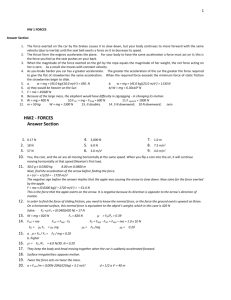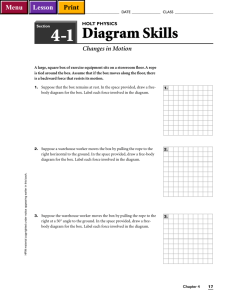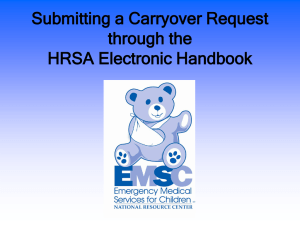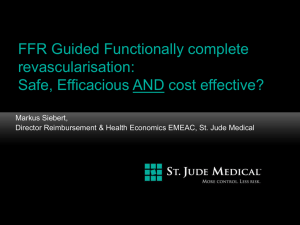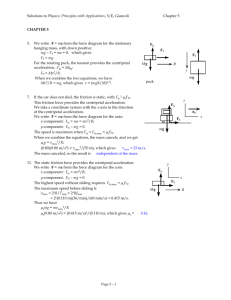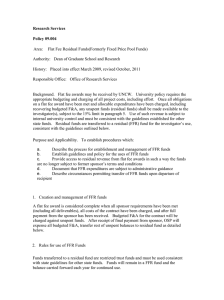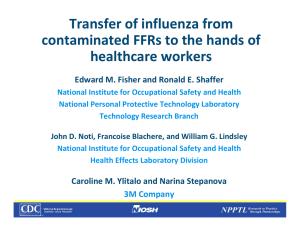Filtering Facepiece Respirators and Viable Microbial Aerosols NIOSH Personal Protective
advertisement
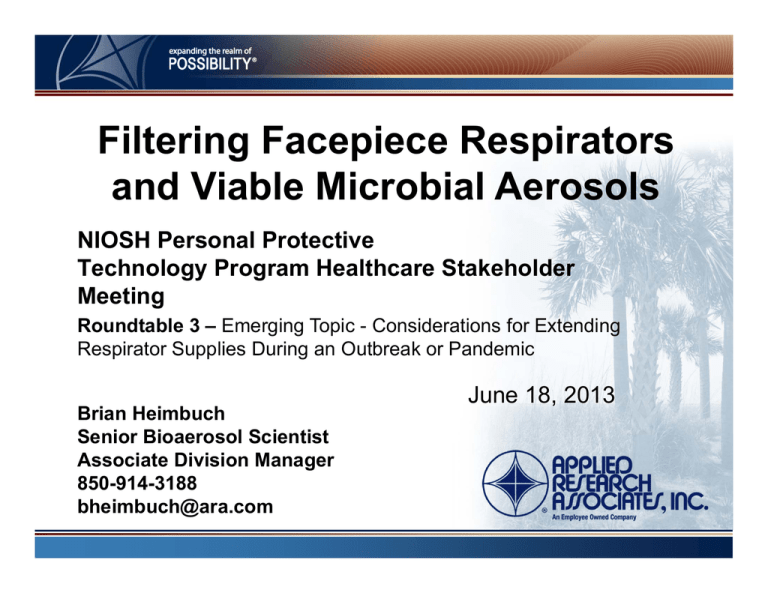
Filtering Facepiece Respirators and Viable Microbial Aerosols NIOSH Personal Protective Technology Program Healthcare Stakeholder Meeting Roundtable 3 – Emerging Topic - Considerations for Extending Respirator Supplies During an Outbreak or Pandemic Brian Heimbuch Senior Bioaerosol Scientist Associate Division Manager 850-914-3188 bheimbuch@ara.com June 18, 2013 FFR Decontamination Study N95 Filtering Facepiece Respirators (FFRs) used for Study 3M 1860 3M 1870 3M 8210 3M 8000 Kimberly-Clark Moldex 2201 2 FFR Decontamination Study Method Conditions Microwave Generated Steam (MGS) 2-minute cycle on a water reservoir 1250 Watt microwave Ultraviolet Germicidal Irradiation (UVGI) 15-minute treatment @ 1.6 – 2.2 mW/cm2 (1.8 X104 J/M2) Low-Temperature Moist Heat (WMH) 30 minutes, 65 °C, 85% RH Graphic 3 FFR Decontamination Study E35 Committee E2721-10 • Similar results were obtained using low-path H5N11 E2721: Standard test method for effectiveness of decontamination of airpermeable materials challenged with biological aerosols containing human pathogenic viruses 1Lore MB, BK Heimbuch, TL Brown, JD Wander, SH Hinrichs, Effectiveness of Three Decontamination Treatments against Influenza Virus Applied to Filtering Facepiece Respirators. Annals of Occupational Hygiene, 2012;56(1):92-101 4 FFR Decontamination Study E2720-10 • Similar results were obtained using low-path H5N11 ASTM 2720: Standard test method for evaluating the effectiveness of decontamination procedures on surfaces challenged with droplets containing human pathogenic viruses E35 Committee 1Lore MB, BK Heimbuch, TL Brown, JD Wander, SH Hinrichs, Effectiveness of Three Decontamination Treatments against Influenza Virus Applied to Filtering Facepiece Respirators. Annals of Occupational Hygiene, 2012;56(1):92-101 5 FFR Decontamination Study Arithmetic Means and Standard Deviation MDFF10 Values across the Control and Three Decontamination Conditions for Six FFR Models 250 225 MDFF10 200 175 150 Control * 125 * UVGI MHI 100 MGS 75 50 25 0 3M 8000 3M 8210 Moldex 2200 KC PFR95 3M 1860 3M 1870 FFR Model * Indicates a statistically significant reduction (P < 0.05) compared with the control • Fit was not significantly degraded 6 FFR Decontamination Study FFR UVGI MGS WMH Control 1.24 ± 0.22 1.26 ± 0.25 1.59 ± 0.27 0.34 ± 0.40 0.66 ± 0.14 1.33 ± 0.24 1.25 ± 0.31 2.14 ± 0.22 0.52 ± 0.35 0.98 ± 0.39 0.70 ± 0.07 0.90 ± 0.29 2.16 ± 0.10 1.06 ± 0.56 0.58 ± 0.07 0.88 ± 0.12 2.05 ± 0.33 2.12 ± 0.41 0.63 ± 0.35 0.64 ± 0.07 Filter Aerosol Penetration (%P) for 3X Decontaminated and Control 3M 8210 0.41 ± 0.24 0.08 ± 0.03 0.43 ± 0.37 0.62 ± 0.19 FFRs (n=3) 3M 8000 Moldex 2201 KC PFR 3M 1870 3M 1860S • Filtration efficiency was not significantly degraded 7 FFR Cleaning Study • The Food and Drug Administration (FDA) requires that reprocessed single-use medical devices be cleaned and sterilized, and that their functional performance be demonstrated2 • Cleaning studies were performed on 3M1860, 3M1870, and Kimberly-Clark N95 surgical FFRs contaminated with S. aureus and artificial saliva using ASTM E2721 2Medical Wipe Product Active Ingredient Pampers® Wipe None 3M™ 504/07065 Respirator Cleaning Wipe Benzalkonium Chloride (BAC) Current Technology Inc. Hype-Wipe® Hypochlorite (OCL) Device User Fee and Modernization Act of 2002, Public Law 107–250. 8 FFR Cleaning Study S. aureus Removal using Pampers Wipe Artificial Saliva Removal using Pampers Wipe 100% Percent Reduction Percent Reduction 100% 90% 80% 70% 60% 50% 60% 40% 20% d d 0% 3M 1860 3M 1870 Kimberly-Clark Interior and exterior of FFRs were evaluated Nose pads 80% Edge Strips 3M 1860 3M 1870 Kimberly-Clark Only exterior of FFRs was evaluated FFR Fabric • OCL wipe showed 4 – 5 log reduction of S. aureus on most surfaces • Nose pads for 3M1870 had1 – 2 log reduction • BAC wipe showed 2 – 5 log reduction of S. aureus on all surfaces • Edge strips of Kimberly-Clark FFR showed 4 – 5 log reduction • BAC wipe removal of artificial saliva was similar to Pampers wipe 9 FFR Cleaning Study Effect of Cleaning on Particle Removal Efficiency Percent Penetration 6% 3MTM wipe (Benzalkonium Chloride) 4% Hype-Wipe® (Hypochlorite) 2% Pampers® wipe 0% 3MTM 1860s 3MTM 1870 KC® PFR FFR Model (n=3) 10 FFR Hospital Wear Study • Environmental staff at Bay Medical Center (Panama City, FL) wore FFRs while cleaning discharged patient rooms • FFR wear time was ~25 minutes • Staff was trained to don and doff the FFRs to avoid contact contamination of the FFRs by touching • Following doffing, the FFRs were deconstructed and bacterial isolates were collected using permissive media 11 FFR Hospital Wear Study Viable Bacterial Isolates Recovered From FFRs • 73% of the Gram-positive and 67% of the Gram-negative isolates evaluated were resistant to oxacillin • Vancomycin resistance was 9.2% and 36.7%, respectively 12 Viable H1N1 Evaluation of FFRs Average Removal Efficiencies of 0.8-µm Particles at 85 LPM FFR Model Inert H1N1 influenza p -value 3M 1860S 99.85% ± 0.10% 99.27% ± 0.38% 0.08 3M 1870 99.90% ± 0.09% 99.13% ± 1.36% 0.45 Kimberly–Clark 99.72% ± 0.16% 98.93% ± 0.36% 0.02 SafeLife T5000 99.999% ± 0.001% 99.996% ± 0.002%a 0.09 99.23% ± 1.00% GSK Actiprotect 99.94% ± 0.06% 0.19 Average Removal Efficiencies of 0.8-µm Particles at 170 LPM FFR Model Inert H1N1 influenza p -value 3M 1860S 99.37% ± 0.39% 98.56% ± 0.87% 0.13 3M 1870 99.96% ± 0.03% 99.59% ± 0.27% 0.14 Kimberly–Clark 98.37% ± 0.32% 96.29% ± 0.56% 0.02 SafeLife T5000 99.994% ± 0.009% 99.995% ± 0.002%a 0.9 96.29% ± 2.49% GSK Actiprotect 99.23% ± 0.15% 0.09 13 Path Forward Data from these studies can be used for both short-term and long-term solutions for mitigating an FFR shortage Short-Term Solution • FFRs are robust enough to be decontaminated • FFRs cannot be cleaned according to FDA guidelines, but we do not think cleaning is necessary based on projected operational guidelines • Risk cannot be eliminated, but could be reduced with a little more research aimed at specific risk factors 1. Strain resistance risk 2. Repeated exposure complications 3. Universal application 4. Increased decontamination cycles 5. Transition preparations for UVGI technology 14 Path Forward Data from these studies can be used for both short-term and long-term solutions for mitigating an FFR shortage Long-Term Solution • Data from these studies can be used to develop better FFRs • Reuse is approved within a shift • Reuse between patients will be allowed during a pandemic • Development of a decontaminatable FFR is allowable and could meet current NIOSH and FDA approval guidelines4 • Co-develop cleaning protocols/devices • Material and design features can be optimized based on our data 4Heimbuch BK, Harnish D. (2011) Discussions on Short-Term and Long-Term Solutions to Mitigate a Shortage of Filtering Facepiece Respirators Caused by Pandemic Influenza, Final Report from Interagency Meeting, Food and Drug Administration-Centers for Devices and Radiologic Health. Available from the Food and Drug Administration 15 Acknowledgements 16
